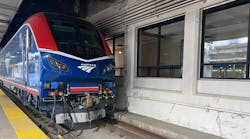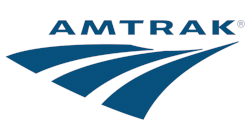Federal, state and local officials joined Amtrak and other stakeholders at Chicago Union Station to celebrate the start of 110 mph rail service between St. Louis, Mo., and Chicago. Amtrak’s state-supported Lincoln Service train on June 26 was the first train to make the trip between the two cities at higher speeds.
The 110-mph service will save passengers 15 minutes versus the previous speeds of 90 mph and 30 minutes on the corridor’s initial speed of 79 mph before track, signaling and other enhancements to improve train speeds began.
"Illinois is the only state where all seven of the nation's largest railroads operate. That's a unique economic advantage recognized by employers across the globe, helping our state attract and maintain quality jobs," said Illinois Gov. JB Pritzker. "By upgrading to higher-speed service on Illinois' largest passenger rail line, we are solidifying our status as the transportation hub of North America. Investments like these do more than just connect cities - they allow our residents to access opportunities beyond their immediate neighborhoods, streamline regional collaborations and open doors for new jobs and new businesses."
Illinois Department of Transportation (IDOT) was awarded an initial federal grant in 2010 to develop the corridor into a higher speed rail line, working with partners at Amtrak and Class 1 railroad Union Pacific. The corridor will host both Amtrak passenger trains and freight trains.
"Union Pacific is proud to have been a part of this large-scale, multiyear undertaking to safely accommodate both freight and high-speed passenger trains on the same rail line," said Union Pacific Chairman, President and CEO Lance Fritz. "This project embodies the true meaning of partnership and underscores what can be accomplished when we come together and pull in the same direction."
The $1.96 billion project involved work to improve track infrastructure, including the installation of concrete crossties, along with bridge, culvert and signaling systems improvements. Safety along the corridor has been enhanced with the upgrade of 212 grade crossings with four-quadrant gates and loop detectors. Additionally, 39 crossings were closed, and pedestrian gates and fencing were built to protect people crossing tracks passing through towns and neighborhoods. New stations were constructed in Dwight, Pontiac, Lincoln, Carlinville and Alton while station upgrades were performed at Bloomington-Normal and Springfield. Trains will stop at Joliet’s new multimodal station that was completed in 2018 as a separate project.
"The team at IDOT, Amtrak, and UP has delivered travel times that will make a real difference to our customers: Less than two hours from Chicago to Bloomington-Normal and shorter than three hours to Springfield, with end-to-end St. Louis-Chicago schedules of under five hours," said Amtrak President Roger Harris. "Between the shorter schedules and having more than half of all the new state-owned Amtrak Midwest ‘Venture' railcars now in service, we are completing a full makeover of this corridor service. We thank Gov. Pritzker and the entire Illinois congressional delegation for their leadership and support."
The final component of the project involves new locomotives and railcars that will be used throughout the region for passenger rail service. Amtrak has placed 33 new Charger locomotives into service since 2017. The Charger locomotives are the first higher-speed passenger locomotives to meet Tier 4 emissions standards.
More than 50 new railcars are currently in service on Amtrak routes throughout the Midwest. Illinois is part of a consortium of states working to procure 88 new single-level railcars that are fully accessible for persons with disabilities for use in Illinois, Missouri, Wisconsin and Michigan.

Mischa Wanek-Libman | Group Editorial Director
Mischa Wanek-Libman is director of communications with Transdev North America. She has more than 20 years of experience working in the transportation industry covering construction projects, engineering challenges, transit and rail operations and best practices.
Wanek-Libman has held top editorial positions at freight rail and public transportation business-to-business publications including as editor-in-chief and editorial director of Mass Transit from 2018-2024. She has been recognized for editorial excellence through her individual work, as well as for collaborative content.
She is an active member of the American Public Transportation Association's Marketing and Communications Committee and served 14 years as a Board Observer on the National Railroad Construction and Maintenance Association (NRC) Board of Directors.
She is a graduate of Drake University in Des Moines, Iowa, where she earned a Bachelor of Arts degree in Journalism and Mass Communication.





